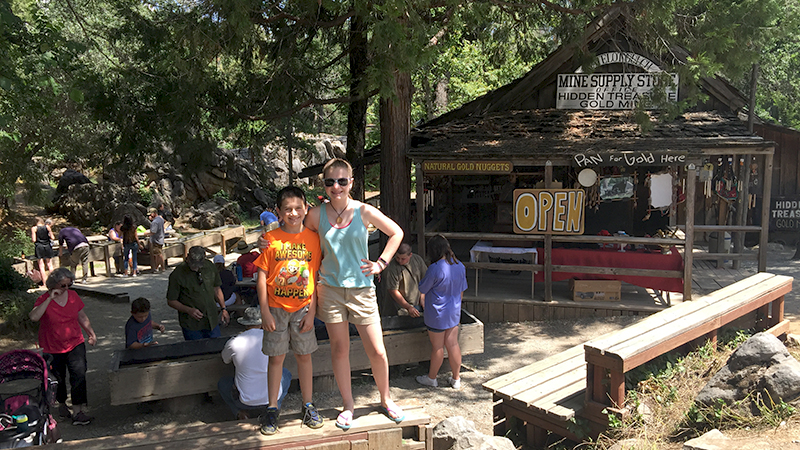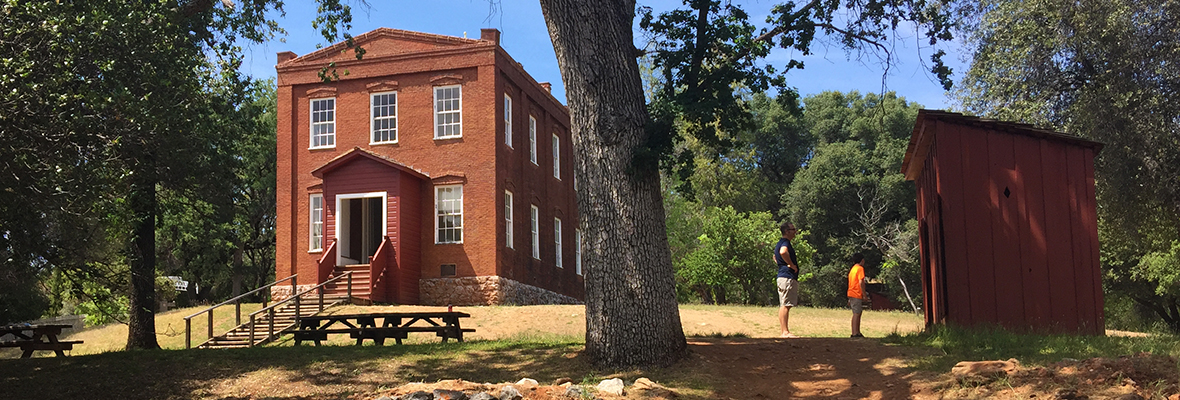
In the Sierra Nevada foothills and the heart of gold country is Columbia State Historic Park, a California Gold Rush Town boasting the largest collection of gold rush-era buildings in the state of California and a preserved bustling business district.
After our family adventure visiting Railtown 1897 State Historic Park and relaxing along Main Street in Historic Jamestown, we continued our day trip to Columbia, California and the Columbia State Historic Park. We visited the park when the kids were super little, but to be honest, didn’t remember much about it — those were the days of very little sleep, as I was getting my business off the ground.
I am so happy we made the decision to go back to Columbia State Historic Park, a California Historical Landmark, especially with Carter now wrapping up fourth grade and a year of learning about the California Gold Rush!
Visiting Columbia State Historic Park
Visiting Columbia is an opportunity to see what it’s like to live in a gold rush era mining town. With shop owners and purveyors in period costumes, a working blacksmith shop, a theater, and several small museums, it truly feels like you’re stepping back in time. The business district — open year-round, seven days a week — has a variety of shops offering gold rush era items, as well as restaurants and saloons, ice cream parlors and candy stores, and even a portrait studio.
With a 100 year-old stagecoach available to ride, gold panning and candle making activities, historic buildings to tour, and picnic tables and barbecue grills available throughout the park, there is no shortage of family fun. Plus, free admission, free parking, and free guided tours by docents make Columbia State Historic Park a budget-friendly family adventure.
We have the done gem panning and gold panning activities at other State Parks and Gold Mines, so we skipped that activity this time, but just past the gold panning area there is a collection of giant rocks to climb on. This is one of Carter’s favorite things to do, so when I pointed them out, he ran over and discovered that it’s not just a big grouping of rocks.
There is actually a meandering path through and between the rocks and an old shelter building tucked into the outcropping — and what’s even more awesome is that these rocks are what’s left after the outcropping was attacked with powerful water cannons during the hydraulic gold mining. So they are odd shapes and easy for kids to climb on and explore.
After exploring the main street of town, we hiked up to the old cemetery and two-story brick schoolhouse. Set among old oak trees, the schoolhouse building is stunning.
While we enjoyed getting a look at the schoolhouse classrooms, the kids were more interested in the outhouses! There is also a one mile nature trail through the brushlands, but it was 4:00 pm and almost 100 degrees, so we skipped the sweat hike and grabbed ice cream cones and fresh squeezed lemonade back in town.

The Gem Of The Southern Mines
By 1853, Columbia was one of the largest cities in California, with an estimated population of 25,000 to 30,000.
Between 1850 and the early 1900s, as much as $150 million in gold was mined here. Gold from Columbia helped to finance the United States government and the Union Army during the Civil War.
Unlike many other gold rush towns that burned to the ground or disappeared due to vandalism, wear, and time, Columbia survived. While Columbia never became a ghost town, by the 1940s the buildings had deteriorated and were unsafe. When Columbia became a state park in 1945, restoration efforts began on the 150-year-old structures to capture and preserve their historic value.
Columbia State Historic Park History
Here is a brief historical overview, from the State Park brochure, of Columbia’s beginning, the population, and the mining operations in the area:
Native People
For thousands of years, Indian people resided in the valleys, foothills and mountains of Central California. The Central Sierra Miwok lived in the Columbia area.
Traditional Miwok culture was sensitive to the land and changing seasons, which sustained and guided their daily activities. Large, multi-family villages were located in clearings near oak groves and dependable water sources. Acorns were a major part of their diet, supplemented by fish, birds, deer, small game, insects and native plants. Evidence of camps and grinding rocks can still be seen in or near oak groves.
The native people’s way of life was drastically altered when newcomers to the area introduced diseases and increased warfare in the region. Despite the devastating malaria epidemic of 1833 and abuses and deaths suffered during the gold rush, the descendants of native Miwok and Yokuts Indian people survive today.
Columbia’s Beginning
On March 27, 1850, a group of prospectors discovered gold here. Passing through this area, Dr. Thaddeus Hildreth, his brother George, John Walker and others were caught in a rainstorm. While drying out their gear, Walker decided to try his luck in the nearby gulch. Within six weeks his findings attracted thousands of miners. Their crowded camp of log cabins and canvas tents, known as Hildreth’s Diggings, was formally renamed “Columbia” on April 29, 1850.
By 1852 more than 150 stores, shops, saloons and other business enterprises were operating in Columbia. The town also had three churches, a meeting hall, a Masonic Lodge and a branch of the Sons of Temperance.
A Diverse Population
Miners from the nearby towns of Sonora and Jamestown were the first to arrive. Two-thirds of the miners were Mexican, but by the summer of 1850, many had left Columbia due to the exclusionary Foreign Miner’s Tax, which required foreign-born miners to pay the state $20 a month for the privilege of mining. Like many mining towns, by 1852 Columbia had a sizeable population of Chinese, French, Irish, Italian, German and Jewish miners and merchants who contributed to the growing cultural and ethnic diversity of Columbia.
Water and Fire in Columbia
Water was essential for placer mining. In a dry “diggins” like Columbia in 1850, when the seasonal rains were gone most of the miners left. In June 1851 the Tuolumne County Water Company was formed to transport water from the Stanislaus River about 20 miles away. The company engineered and built a complex system of wooden flumes, pipes and ditches to convey river water to Columbia.
Its high water rates sparked a competitor in 1854 — the Columbia and Stanislaus River Water Company. This company of miners was determined to build a 60-mile aqueduct known as the Miner’s Ditch to supply water more cheaply. However, before its completion, the threat of bankruptcy prompted the sale of the system to the Tuolumne County Water Company.
Water was also extremely important for fire protection in the booming town. In 1854, Columbia’s first fire destroyed six city blocks, leaving the only brick building, the Donnell and Parsons store, standing at the corner of Main and Washington streets. After the fire, a company called the New England Water Company constructed seven cisterns beneath the streets of Columbia to hold water for domestic and fire-fighting use. A square lid to one of these cisterns may be seen today in front of the firehouse on State Street. The town was quickly rebuilt using locally produced red brick. In 1857 another fire struck Columbia’s downtown, leaving only brick buildings with thick walls and iron shutters intact.
Columbia Gold Mining
With improved water delivery to Columbia, miners began to employ more efficient mining methods in their quest for gold.
In some places, open pit placer mining operations removed more than 60 feet of dirt and washed it through a system of sluices to remove the gold. Using water power, the miners hoisted gravel from deep placer deposits to higher ground, where it could be processed using hydraulic methods. The result of their efforts left expansive limestone formations, visible today below the main parking lot. The diggins were enormously productive, at times averaging $100,000 or more per week.

Columbia State Park Living History Events
No matter when you visit Columbia State Historic Park, you’ll find at least a few business owners and docents in period costumes, but if you want to really experience the mining town as it was during the gold rush, you should visit the park during the Gold Rush Days.
On the second Saturday on every month, the Gold Rush Days living history event happens from 1:00-4:00 pm, and features special exhibits and docents in period attire who lead programs and offer special hands-on activities throughout the park.
During the Columbia Diggins Tent Town 1852 annual event — a reenactment of a gold rush tent town and demonstration of daily life — you can wander through the early tent town, enjoy entertainment at the Theater, step into the Saloon and order a sarsaparilla, or browse in the authentically recreated Brown’s Mercantile. Bakers produce bread out of a stone and brick oven, and you can observe costumed docents demonstrating a variety of early mining techniques.
Take a Day Trip to Columbia, California
Columbia neighbors other historic towns in the Sierra Nevada foothills including Sonora, Jamestown, and Angels Camp making it a popular destination for day-trippers and weekenders like our family.
We visited Jamestown and Railtown 1897 in the morning and Columbia State Historic Park in the afternoon, and it was a perfect family day trip.
If you get the chance to visit this historic gold rush era town, I’d love to know what you think!










